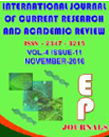Abstract Volume:4 Issue-11 Year-2016 Original Research Articles
 |
Online ISSN : 2347 - 3215 Issues : 12 per year Publisher : Excellent Publishers Email : editorijcret@gmail.com |
Industrial effluents containing heavy metals may consider a major source of contamination causes serious environmental problems. Decontamination of heavy metals from wastewater has been a challenged for a long time. A number of methods have been developed for removal of toxic metal ions from wastewaters such as precipitation, evaporation, electroplating, ion exchange, membrane processes, etc. However, these conventional technologies are providing expensive due to non- regenerable materials used, high cost and generation of toxic sludge. Biosorption is a process which represents a biotechnological innovation as well as a cost effective excellent tool for removing heavy metals from aqueous solutions. It represents a typical technique for using economical alternate biological materials for the purpose. Today, biosorption is one of the main components of environmental and bioresource technology. Application of microorganisms (specifically bacteria, algae, yeasts and fungi) as biosorbents for heavy metal removal have received growing interest due to high surface to volume ratio; large availability, rapid kinetics of adsorption and desorption and low cost. The aim of the present study is to review the removal of heavy metals from aqueous solutions using various materials of biological origin such as fungi, algae, yeast and bacterial biomass. This review discuss the significance of heavy metal removal from waste streams and provides brief overview of potential of biosorbents and biosorption technology, highlights the undelaying features of biosorption and the operation conditions such as pH, dose required, initial concentration, temperature, and treatment performance.
How to cite this article:
Kalyani, P., and Hemalatha, K.P.J. 2016. Biosorption of Heavy Metals in the Environment-A Review Paper.Int.J.Curr.Res.Aca.Rev. 4(11): 66-74doi: http://dx.doi.org/10.20546/ijcrar.2016.411.011



Quick Navigation
- Print Article
- Full Text PDF
- How to Cite this Article
- on Google
- on Google Scholor
- Citation Alert By Google Scholar
